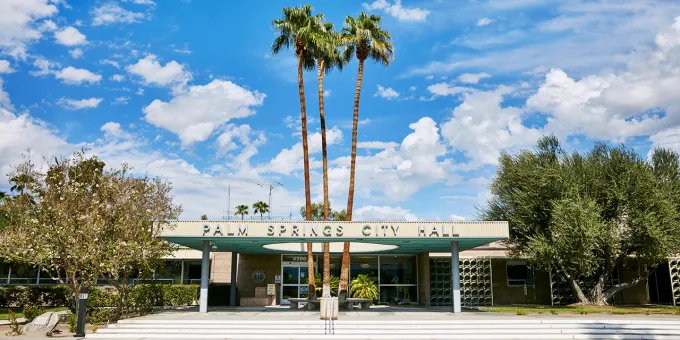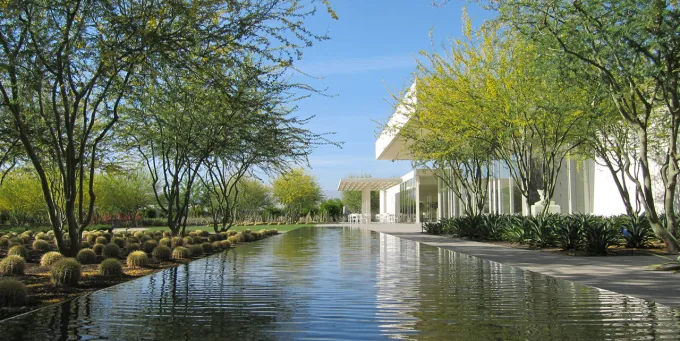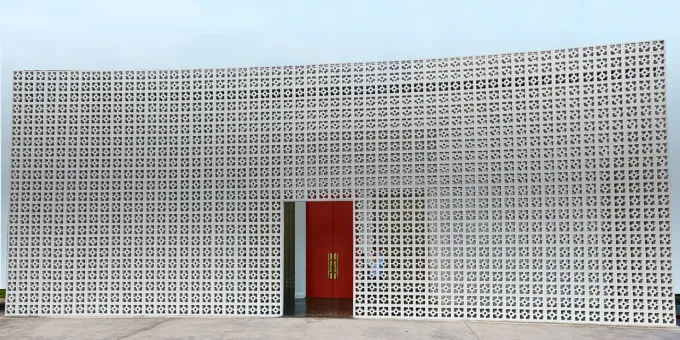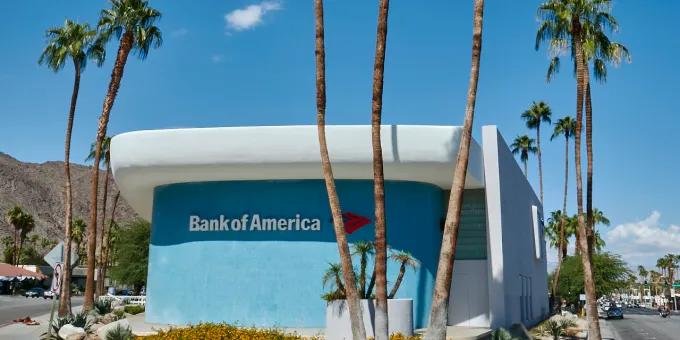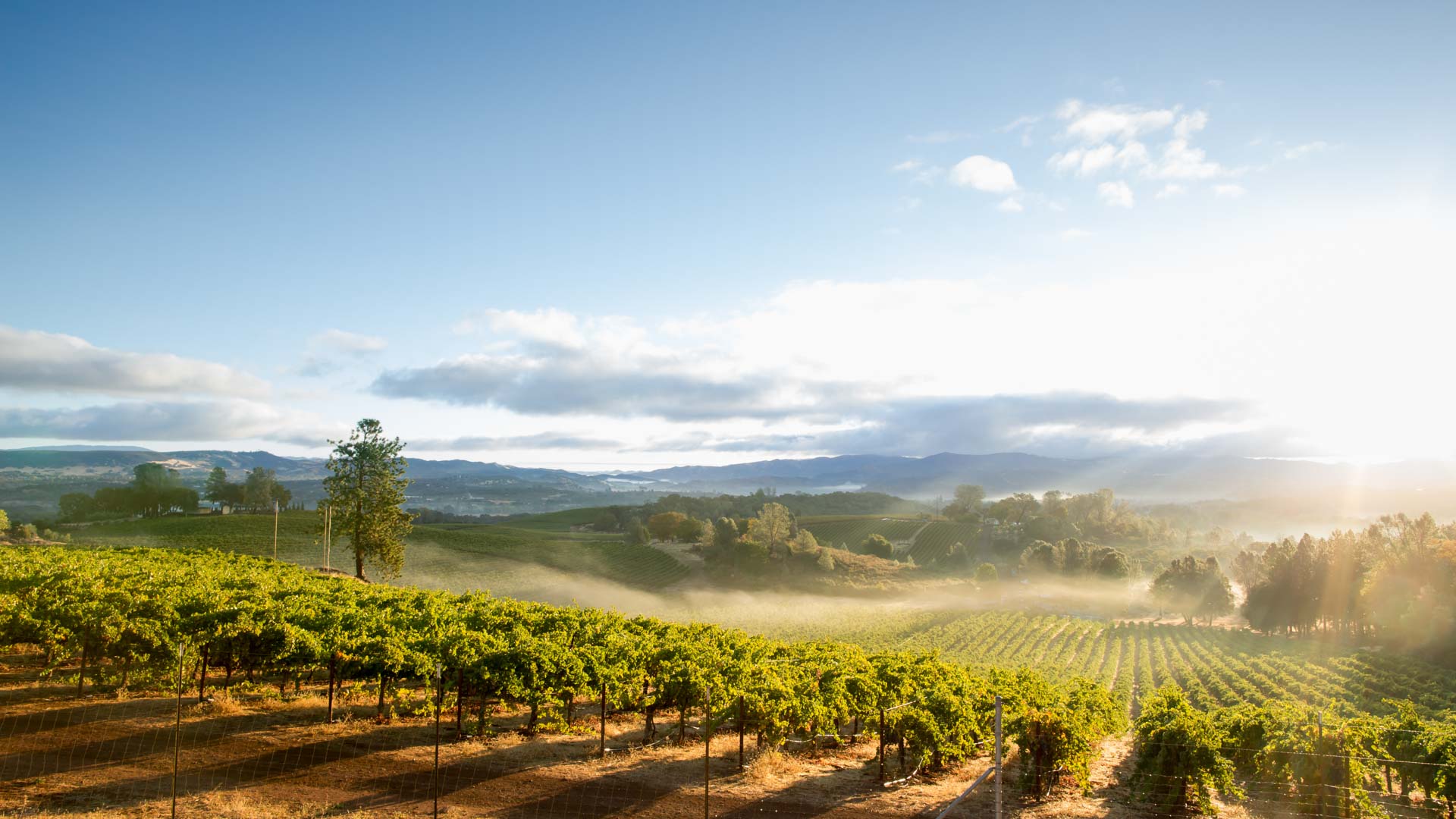No California city is as closely identified with midcentury modern architecture as Palm Springs. Visionaries like Richard Neutra, Albert Frey, E. Stewart Williams, and Donald Wexler designed and constructed hundreds of futuristic buildings here between 1945 and 1975, using geometric lines and sleek façades to reflect the optimism of the Atomic Age and accent the desert's brilliant skies and folded hills. Here’s where you can find nine of these space-age architectural gems and learn about the innovative creators behind them:
1. Palm Springs Visitors Center
The Palm Springs Visitors Center anchors the base of Tramway Road with its space-age profile and triangular roofline, adding a dash of geometric flair to the arid landscape. Built in 1965 as the Enco Tramway Gas Station, this glass-and-steel landmark is known for its soaring, wing-like roof, which architects Albert Frey and Robson Chambers called a "hyperbolic paraboloid." It slants upward from the building's midline, extending 95 feet beyond the front door to create a shady veranda supported by steel tubular poles. Walk inside to learn about where to stay, play, dine, and hike in the greater Palm Springs area and pick up a free map detailing more of the region's midcentury modern buildings. (More: Palm Springs Visitors Center)
2. Twin Palms, the Frank Sinatra Estate
When Frank Sinatra made his first million dollars and moved to Palm Springs in 1947, he wanted a house that matched his dazzling celebrity. Architect E. Stewart Williams fulfilled the crooner's wish with Twin Palms, a sprawling 4,500-square-foot mansion with four bedrooms, seven bathrooms, and a piano-shaped swimming pool in the backyard. When completed, the chic estate, with its low, rectangular wings, flat roof, and massive sliding glass doors set the standard for mid-20th century Hollywood glamour. Take a 45-minute private, guided tour of Twin Palms or rent the house for an unforgettable dinner party, wedding, photo shoot, or weekend getaway. (More: Twin Palms)
3. Sunnylands Center and Gardens
The 25,000-square-foot home built for publishing magnate and diplomat Walter Annenberg and his wife, businesswoman and philanthropist Leonore Annenberg, is the showpiece of Sunnylands' 200-acre estate that holds 11 lakes, nine acres of gardens, tennis courts, and a private golf course. Designed by architect A. Quincy Jones in the 1960s, the pink-walled property incorporates such modern features as open atriums lined with volcanic stone, a pyramidal roof inspired by Mayan architecture, gleaming glass walls, and furniture by Hollywood’s legendary decorator-to-the-stars, William Haines. Reserve tickets in advance for a tour of the house or visit any time for a stroll in the gardens. (More: Sunnylands Center and Gardens)
Modernist architect Donald Wexler believed that steel was the perfect choice for desert building—it stood tough against sun, heat, and wind, and it was inexpensive. In 1961, he planned to bring affordable housing to Palm Springs by building a 40-home subdivision out of prefabricated steel and glass. Wexler's 1,400-square-foot steel homes were stylish, affordable, and could be assembled in under 30 days. But even with his visionary design skills, Wexler couldn’t foresee the skyrocketing price of steel. Only seven of his steel houses were built before the project was scrapped due to rising costs. In 2012, one of Wexler's prefabs was the first midcentury structure to be placed on the National Register of Historic Places. (More: Wexler Steel Houses)
The 5,000-square-foot residence where The King and Priscilla enjoyed postnuptial bliss in 1967 is also a midcentury treasure that Look magazine called "The House of Tomorrow." The home was designed by William Krisel and Dan Palmer in 1960 as four connecting circular pods. The interior boasts a 64-foot built-in banquette sofa, lava rock walls that seem straight out of The Flintstones, terrazzo flooring, a "floating" fireplace, and other era-defining elements. The grounds include a large gunite swimming pool and stunning vistas of the San Jacinto Mountains. The architects called the streamlined mansion "an experiment in modern living." Note: In December 2020, it was purchased by new owners, and it's unknown whether tours will still be offered. You can still catch a glimpse by driving by 1350 Ladera Circle. (More: Elvis’ Honeymoon Hideaway)
Built in 1959 as California’s first Holiday Inn, the celebrity-favored Parker Palm Springs is a perfect mash-up of Palm Springs’ 1950s roots and post-modern eclecticism. With a reimagined interior by design star Jonathan Adler, the hotel overflows with eclectic, whimsical, and unconventional touches, like macramé owls in the groovy-chic lobby, a seven-foot-tall bronze banana on the main lawn, and a yellow-striped lemonade stand. Enjoy an indulgent meal here, rent the private gated residence that once belonged to cowboy singer Gene Autry, or sleep in one of 12 one-bedroom villas or 130 suites and rooms. (More: Parker Palm Springs)
Under the leadership of Swiss-born master Albert Frey, some of desert-modern design's biggest names—E. Stewart Williams, Robson Chambers, and John Porter Clark—helped to create this 1952 concrete-and-steel building’s signature look, including a portico with a huge circular hole graced by a trio of towering palms. Colonnades around the perimeter create partially covered walkways that lead to grassy lawns and mature trees, making the building seem more like a golf clubhouse than a civic office. Aluminum "brise soleil" walls shade the building and cast changing shadow patterns as the sun moves throughout the day. (More: Palm Springs City Hall)
Considered one of the most important American houses of the 20th century, this spectacular desert getaway was designed by architect Richard Neutra in 1946. Made of steel, glass, and Utah stone, the 3,162-square-foot compound lies in a cross shape with an airy living and dining room in the center. Four "wings" that contain the kitchen, master bedroom, and four guest bedrooms branch outward through covered breezeways. Sliding glass walls open up to expansive lawns, granite boulders, cacti and palm gardens, and a sparkling swimming pool. The home was made famous by Slim Aarons' 1970 photograph "Poolside Gossip," which has been printed on everything from tote bags to lunchboxes. (More: Kaufmann House)
A popular architecture magazine of the mid-20th century called this “the most beautiful bank in America," and the building remains much as it was on its opening day in 1959. Now home to a Bank of America branch, the former City National Bank resembles a vibrant blue-and-white mushroom, or, as some say, a white cloud against a blue sky. Its eye-catching triangular shape, bulbous styling, and rounded roof set it apart from the more common box-shaped buildings of the midcentury era. Architect Rudy Baumfeld said his inspiration came from the 1954 Chapel Notre Dame du Haut in Ronchamp, France, designed by Swiss-French architect Le Corbusier. (More: Bank of America Building)
